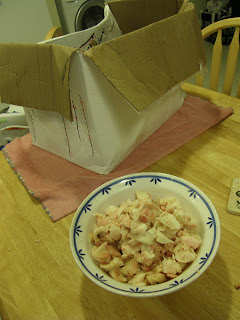We bought a half a beef last fall. They asked if we wanted the scraps, and since I believe in using every part of the animal (since it died for us, I don't want to waste any part of its life), we said yes.
I surmised that the 'scraps' would be soup bones and the like.
I was wrong.
We got a box full of, well, scraps. There was some bone (which did go to make stock of course), but most of it was fat. Cows are fatty animals in case you didn't know or have forgotten (and there is nothing like a whole box full of fat to make sure that I will never ever forget!)
So what does one do with a whole bunch of cow fat? Well render it into tallow and make candles of course!
First, all that fat/gristle/unknown stuff has to be chopped into little pieces (you can see the box there behind my bowl of bits--it was pretty full).
Second, put the bits in a big pan with some water, and boil for a loooong time until all the fat becomes liquid (keep an eye on it, because the water will boil off and then things get ugly and stinky and just generally bad...)
Pour the contents of the pan out through a strainer. BE CAREFUL, THIS STUFF IS REALLY HOT!! The things I read recommended straining twice, which I did (once with a bigger-hole metal colander and then once through a fine-mesh strainer). Once it is well strained, pour the remaining liquid--which will be murky--into a dish to separate and cool. The water and fat will separate and the fat will rise to the top and solidify. Give it at least a few hours, I have had the best results with letting it go overnight. (I put it in bread pans here, the square shape made it easier to get the tallow block out later.)
Once the tallow is solid, use a table knife to separate the tallow from the edge of the container. Dump out the water into the toilet. (The bits of tallow will clog up your sink drains, it has to go in the toilet!!) Set out the tallow to dry/drain (I put it on paper towels). It usually seems to have some gunk along it where it bordered the water, so I use the table knife to scrape that scuzzy part off and put it in the garbage or toilet.
I like to let it air out for at least a few hours before using it. If you do not have immediate plans for it, put it in a bag in the freezer.
Coming next: part 2, making the candles!!




2 comments:
Yes, cows in general are fatty animals. But the dairyman's daughter in me would be remiss if I didn't point out that not all cattle are created equal. I'm assuming since you purchased the cow intending it for beef, it was something like a Hereford or Angus, which in general are (2-3 times) fattier than Holsteins and Jerseys (typical dairy cows).
Then again, being a dairyman's daughter, we didn't worry so much about "is this an ideal beef breed" and learned to eat whatever animal wasn't producing milk anymore, whether it was a skinny old jersey with lousy meat (who incidentally was named Tiny...because she was, well, smaller than the Holsteins!) or a messed up steer (named Snoopy...) that didn't fit into your breeding program or wouldn't sell at auction for more than pennies on the dollar.
Yep, even conventional farmers believe in "waste not, want not". Oh, and "who are we eating tonight?"
(And because you and I prefer peer-reviewed sources over anecdotal evidence..."In the development of specialized cattle breeds for production of either meat or milk, differential selection has resulted in the establishment of animals with varying propensities for fat deposition. Examples are the Holstein and Hereford breeds, with Holsteins depositing less body fat than do Herefords (Callow, 1961; Kline et al., 1969)."
"Fat thickness for Herefords and Holsteins averaged 1.95 and 0.64 cm, respectively (P < .001).")
Chew on that fat... (Thank you for humoring my Aspie tendencies...you know you love me!)
Jenni - I'm eager to learn how you make candles from the tallow.
Around here we cook with it. Best fat right behind lard in my kitchen! lol
Also - don't work so hard to render it! Heat your oven to around 200-210 degrees farenheit. Put the chunks in a baking dish, cover it and let it render out for as many hours as it takes. Every now and then pour our the rendered lard into a jar. Simple! And it doesn't ever stink - a big plus around here!
Post a Comment